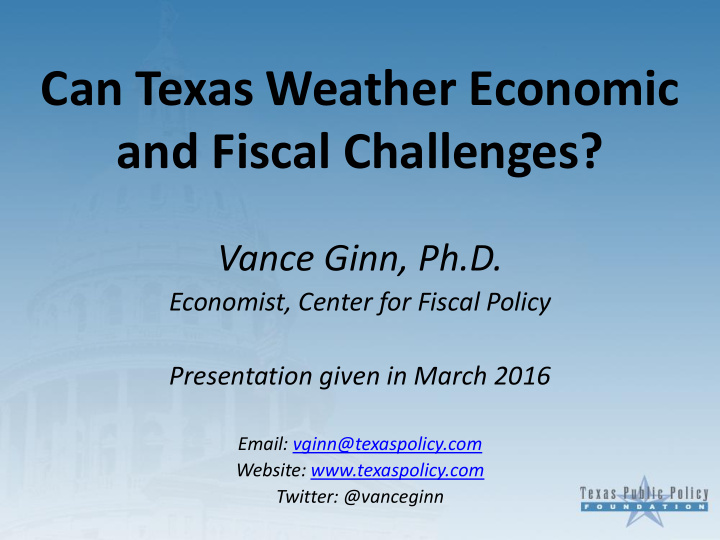



Can Texas Weather Economic and Fiscal Challenges? Vance Ginn, Ph.D. Economist, Center for Fiscal Policy Presentation given in March 2016 Email: vginn@texaspolicy.com Website: www.texaspolicy.com Twitter: @vanceginn
Texas Public Policy Foundation 501(c)3 non-profit, non-partisan free market research institute Foundation is guided by three principles: Liberty Free Enterprise Personal Responsibility Based in Austin, TX
Economic and Fiscal Challenges 12 th largest world economy is hampered by: Slower global economic growth, especially China Federal Reserve tightening credit: too low for too long Low oil prices (15% of real private economy/21% in 80s) First major recession in 30 years? Budget picture looks tight going into 2017 Legislative Session in January Fortunately, 2015 Legislature: Passed a conservative 2016-17 budget: 2.9% increase Passed $4 B in tax and fee relief Left $7 B surplus & $10 B in Rainy Day Fund
Source: TPPF, A Labor Market Comparison: Why the Texas Model Supports Prosperity
Texas, America’s Jobs Engine Texas has created 34% of total U.S. employment increase since pre-Great Recession. 3,500,000 U.S. MINUS T EXAS = +3,158,549 2,000,000 500,000 T EXAS : +1,643,451 T OTAL C IVILIAN E MPLOYMENT -1,000,000 -2,500,000 -4,000,000 U.S. minus Texas employment -5,500,000 wasn’t positive until January 2015 and didn’t surpass Texas -7,000,000 until November 2015. -8,500,000 12/2007 12/2008 12/2009 12/2010 12/2011 12/2012 12/2013 12/2014 12/2015 D ATA ARE C UMULATIVE M ONTHLY T OTAL C IVILIAN E MPLOYMENT FROM THE U.S. B UREAU OF L ABOR S TATISTICS FROM 12/2007 TO 2/2016.
Texas Created 170,900 Net Nonfarm Jobs During the Last Twelve Months 6% 6% 4% 4% A NNUAL N ONFARM J OB G ROWTH R ATE 2% 2% 0% 0% -2% -2% F EBRUARY 2016 -4% -4% U.S.: 1.9% CA: 2.8% TX: 1.4% FL: 3.0% NY: 1.4% -6% -6% -8% -8% 2000 2001 2002 2003 2004 2005 2006 2007 2008 2009 2010 2011 2012 2013 2014 2015 2016 S EASONALLY ADJUSTED NONFARM EMPLOYMENT DATA ARE FROM THE B UREAU OF L ABOR S TATISTICS .
Texas' Unemployment Rate Lower than U.S. Average for 110 Consecutive Months 13% 13% F EBRUARY 2016 U.S.: 4.9% CA: 5.5% TX: 4.4% FL: 4.9% 11% 11% NY: 4.8% U NEMPLOYMENT R ATE 9% 9% 7% 7% 5% 5% 3% 3% 2000 2001 2002 2003 2004 2005 2006 2007 2008 2009 2010 2011 2012 2013 2014 2015 2016 S EASONALLY ADJUSTED NONFARM EMPLOYMENT DATA ARE FROM THE B UREAU OF L ABOR S TATISTICS .
Texas' Unemployment Rate Lower than U.S. Average for 109 Consecutive Months 13% 13% J ANUARY 2016 U.S.: 4.9% CA: 5.7% TX: 4.5% FL: 5.0% 11% 11% NY: 4.9% U NEMPLOYMENT R ATE 9% 9% 7% 7% 5% 5% 3% 3% 2000 2001 2002 2003 2004 2005 2006 2007 2008 2009 2010 2011 2012 2013 2014 2015 2016 S EASONALLY ADJUSTED NONFARM EMPLOYMENT DATA ARE FROM THE B UREAU OF L ABOR S TATISTICS .
Not Just Oil and Gas Jobs: Texas Job Creation from 2000 to 2014 Source: TPPF, A Labor Market Comparison: Why the Texas Model Supports Prosperity , data in parentheses are that sector’s share of the labor force.
Job Growth Across All Wage Quartiles from 2000 – 2014 Source: TPPF, A Labor Market Comparison: Why the Texas Model Supports Prosperity
Economic Challenges Mining industry today: 15% of real private economy; 2.5% of labor force Mining industry 1980s: 21% of real private economy; 5% of labor force More diversification from market activity, NAFTA, pro-growth policies Still, low oil prices, slower global growth, and federal government are impediments TX will have another recession one day
Fiscal Challenges No recent examples of consecutive conservative budgets: 2001 session was followed by a $10 billion shortfall in 2003 met with spending cuts without raising taxes 2009 session accepted “stimulus” payment from the federal government and papered over in 2013 2015 session passed a conservative budget, cut taxes, and left money on the table Legislature should do so again in 2017
Total 2016-17 All Funds Budget: $209.1 Billion (2.9% increase) $53.3 B, $77.2 B, $68.0 B, Other Health & Federal Human Funds $106.0 B, Services General Revenue $7.8 B, General Revenue-Dedicated $78.6 B, Education $27.3 B, Other
All Funds spending is up $209 $210 68.7% since 2004-05. $203 $200 $185 $190 $183 $189 $180 $167 Billions $170 $176 $168 $160 Spending adjusted for $158 $150 compounded population $139 growth plus inflation of 55% $140 $146 is up 9 % since ’04 - ’05 $124 $130 $135 $120 2004-05 2006-07 2008-09 2010-11 2012-13 2014-15* 2016-17* Source: Legislative Budget Board's Fiscal Size-Up and authors' calculations.
Drop in expected economic growth and oil prices lower revenue projections $ in Thousands FY2016 (BRE) FY2017 (BRE) FY2016 (CRE) FY2017 (CRE) Real GDP 3.2% 4.1% 2.4% 2.3% Nonfarm Employment 2.2% 2.3% 1.7% 1.8% Unemployment Rate 5.0% 5.0% 4.3% 4.4% Taxable Oil Price $64.52 $69.27 $49.48 $56.52 Sales Tax $29,796,127 $31,685,564 $29,258,665 $30,663,502 Franchise Tax $4,741,992 $4,827,605 $3,528,510 $3,547,819 Net GR-Related Funds $53,778,041 $56,656,471 $51,743,275 $54,023,469 Net Revenue All Funds $104,942,290 $109,428,258 $108,053,259 $105,944,086 BRE: about a $7 B expected surplus CRE: about a $4 B expected surplus Actual could be closer to $0 given current trends
Oil production per day is down only 8% in Texas since March 2015 high Source: Energy Information Administration
Rainy Day Fund looks to end the current budget period with a $10.4 billion balance Source: Legislative Budget Board
Pass another conservative Texas budget such that the 2018-19 budget increase is below pop+inf Eliminate the business margin tax Reform the state’s weak tax and expenditure limit Create the Sales Tax Reduction (STaR) Fund Increase budget transparency Sp Spending ding is is ul ultim imat ately ely taxatio tion, n, so we mu must st co contro rol l the budget get to li limit it the footpr print int of go governme nment. nt.
The American Dream is not dead – it has simply moved to the Lone Star State.
Can Texas Weather Economic and Fiscal Challenges? Vance Ginn, Ph.D. Economist, Center for Fiscal Policy vginn@texaspolicy.com www.texaspolicy.com
Recommend
More recommend